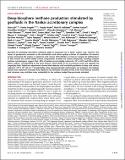Deep-biosphere methane production stimulated by geofluids in the Nankai accretionary complex
Author(s)
Ijiri, Akira; Inagaki, Fumio; Kubo, Yusuke; Adhikari, Rishi R.; Hattori, Shohei; Hoshino, Tatsuhiko; Imachi, Hiroyuki; Kawagucci, Shinsuke; Morono, Yuki; Ohtomo, Yoko; Ono, Shuhei; Sakai, Sanae; Takai, Ken; Toki, Tomohiro; Wang, David T.; Yoshinaga, Marcos Y.; Arnold, Gail L.; Ashi, Juichiro; Case, David H.; Feseker, Tomas; Hinrichs, Kai-Uwe; Ikegawa, Yojiro; Ikehara, Minoru; Kallmeyer, Jens; Kumagai, Hidenori; Lever, Mark A.; Morita, Sumito; Nakamura, Ko-ichi; Nakamura, Yuki; Nishizawa, Manabu; Orphan, Victoria J.; Røy, Hans; Schmidt, Frauke; Tani, Atsushi; Tanikawa, Wataru; Terada, Takeshi; Tomaru, Hitoshi; Tsuji, Takeshi; Tsunogai, Urumu; Yamaguchi, Yasuhiko T.; Yoshida, Naohiro; ... Show more Show less
Downloadeaao4631.full.pdf (2.051Mb)
PUBLISHER_CC
Publisher with Creative Commons License
Creative Commons Attribution
Terms of use
Metadata
Show full item recordAbstract
Microbial life inhabiting subseafloor sediments plays an important role in Earth’s carbon cycle. However, the impact of geodynamic processes on the distributions and carbon-cycling activities of subseafloor life remains poorly constrained. We explore a submarine mud volcano of the Nankai accretionary complex by drilling down to 200 m below the summit. Stable isotopic compositions of water and carbon compounds, including clumped methane isotopologues, suggest that ~90% of methane is microbially produced at 16° to 30°C and 300 to 900 m below seafloor, corresponding to the basin bottom, where fluids in the accretionary prism are supplied via megasplay faults. Radiotracer experiments showed that relatively small microbial populations in deep mud volcano sediments (10² to 10³ cells cm⁻³) include highly active hydrogenotrophic methanogens and acetogens. Our findings indicate that subduction-associated fluid migration has stimulated microbial activity in the mud reservoir and that mud volcanoes may contribute more substantially to the methane budget than previously estimated.
Date issued
2018-05Department
Massachusetts Institute of Technology. Department of Earth, Atmospheric, and Planetary SciencesJournal
Science Advances
Publisher
American Association for the Advancement of Science (AAAS)
Citation
Ijiri, Akira et al. “Deep-Biosphere Methane Production Stimulated by Geofluids in the Nankai Accretionary Complex.” Science Advances 4, 6 (June 2018): eaao4631 © 2018 The Authors
Version: Final published version
ISSN
2375-2548